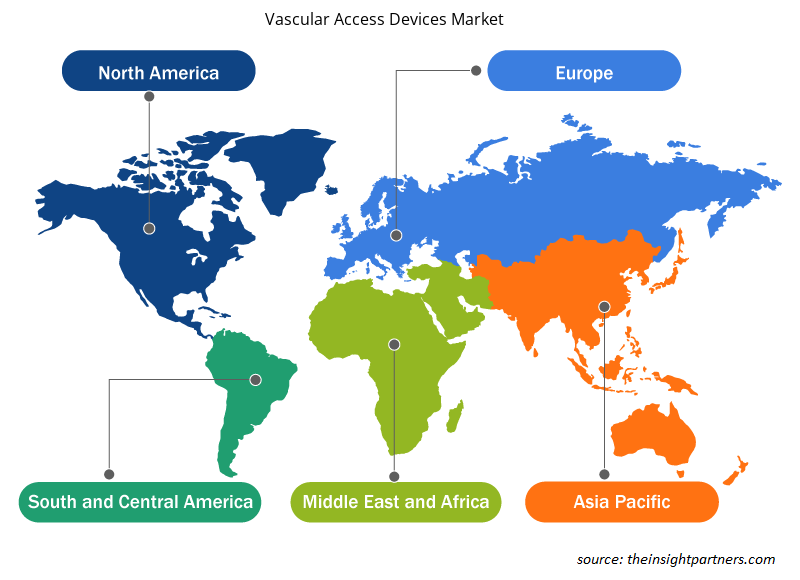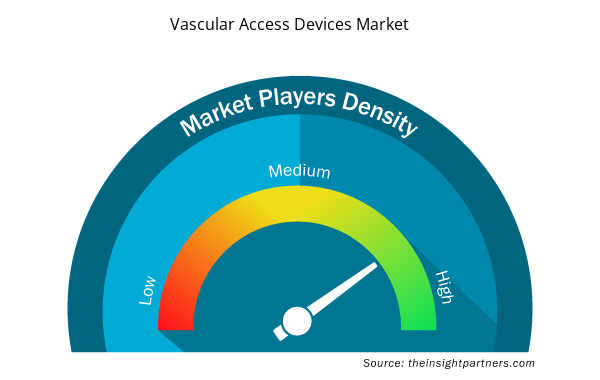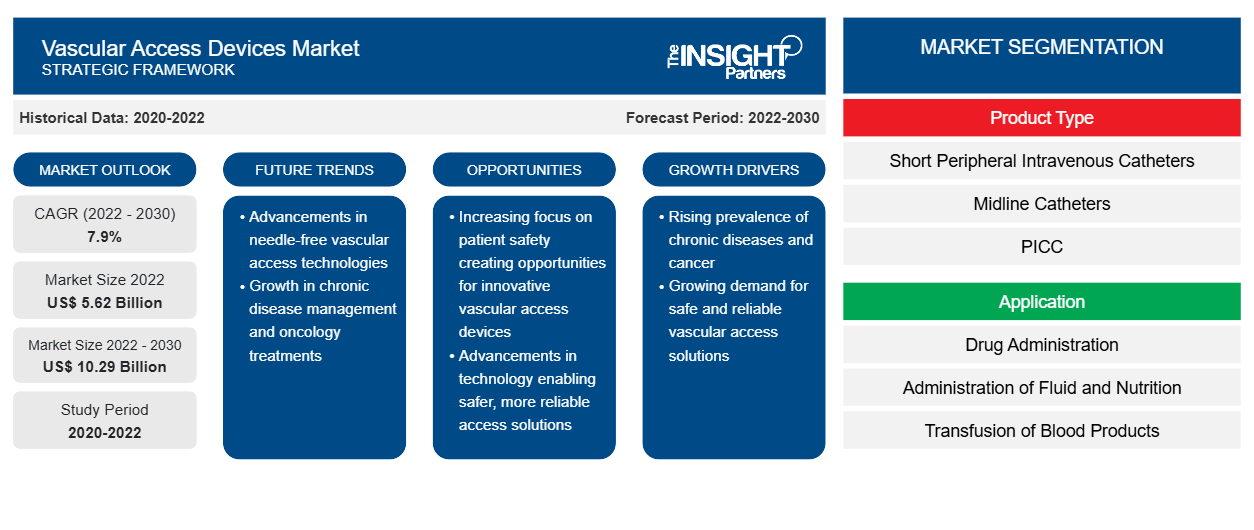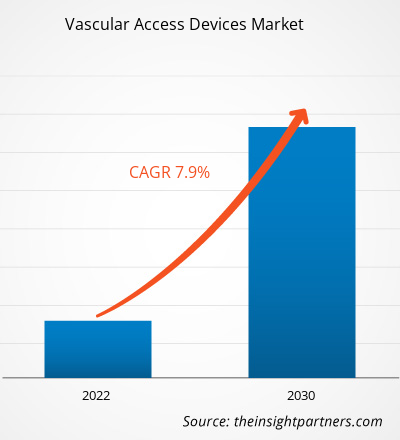[Rapporto di ricerca] Il mercato dei dispositivi di accesso vascolare è stato valutato a 5,62 miliardi di dollari nel 2022 e si prevede che raggiungerà i 10,29 miliardi di dollari entro il 2030. Si prevede che registrerà un CAGR del 7,9% nel periodo 2022-2030.
Approfondimenti di mercato e opinioni degli analisti:
I dispositivi di accesso vascolare vengono posizionati utilizzando una serie di siti anatomici per accedere alla vena cava superiore o inferiore: vena giugulare interna, vena succlavia, vena giugulare esterna e vena femorale. La crescente dimensione del mercato dei dispositivi di accesso vascolare è guidata dalla crescente prevalenza di malattie croniche e dalla crescente necessità di procedure di chemioterapia. Inoltre, le iniziative strategiche delle aziende per rimanere competitive sul mercato alimentano la crescita del mercato. Un aumento significativo nell'uso di dispositivi di accesso venoso robotici abilitati all'intelligenza artificiale porterà probabilmente nuove tendenze di mercato dei dispositivi di accesso vascolare durante il periodo di previsione.
Fattori di crescita e sfide:
La chemioterapia è un trattamento primario o adiuvante utilizzato per ridurre o eliminare i tumori tramite la somministrazione di farmaci potenti. Pertanto, l'aumento dei casi di cancro alimenta la domanda di procedure chemioterapiche. Secondo le stime dell'Agenzia internazionale per la ricerca sul cancro (IARC), nel 2020 sono stati segnalati 19,3 milioni di nuovi casi di cancro a livello globale e si sono verificati circa 10 milioni di decessi a causa della malattia. Secondo il National Cancer Registry (NCR), in Sudafrica sono stati diagnosticati circa 110.000 nuovi casi di cancro, con oltre 56.000 decessi correlati al cancro nel 2020. Inoltre, si prevede che il carico di malattia aumenterà nei prossimi decenni, con nuovi casi di cancro stimati in aumento a 138.000 e 175.000 entro il 2030 e il 2040, rispettivamente, mentre la mortalità correlata al cancro salirà a 73.000 e 94.000 negli stessi anni. Pertanto, la crescente prevalenza del cancro determina la crescita del mercato dei dispositivi di accesso vascolare.
Personalizza questo report in base alle tue esigenze
Riceverai la personalizzazione gratuita di qualsiasi report, comprese parti di questo report, o analisi a livello nazionale, pacchetto dati Excel, oltre a usufruire di grandi offerte e sconti per start-up e università
- Scopri le principali tendenze di mercato in questo rapporto.Questo campione GRATUITO includerà analisi di dati che spaziano dalle tendenze di mercato alle stime e alle previsioni.
Segmentazione e ambito del report:
L'analisi del mercato dei dispositivi di accesso vascolare è stata condotta considerando i seguenti segmenti: tipo di prodotto, applicazione, via di inserimento, utente finale e area geografica. Il mercato, per tipo di prodotto, è segmentato in cateteri endovenosi periferici corti, cateteri midline, PICC (cateteri centrali inseriti perifericamente), cateteri centrali , porte impiantabili e accessori. Il mercato per il segmento dei cateteri centrali è ulteriormente segmentato in CICC (catetere centrale inserito centralmente), FICC (catetere centrale inserito femoralmente) e altri. In base all'applicazione, il mercato dei dispositivi di accesso vascolare è segmentato in somministrazione di farmaci, somministrazione di liquidi e nutrizione, trasfusione di emoderivati e altri. In base alla via di inserimento, il mercato è biforcato in sottocutaneo ed endovenoso. In base agli utenti finali, il mercato è segmentato in ospedali e cliniche, centri chirurgici ambulatoriali e altri. L'ambito del rapporto di mercato sui dispositivi di accesso vascolare comprende Nord America (Stati Uniti, Canada e Messico), Europa (Spagna, Regno Unito, Germania, Francia, Italia e resto d'Europa), Asia Pacifico (Corea del Sud, Cina, Giappone, India, Australia e resto dell'Asia Pacifico), Medio Oriente e Africa (Sudafrica, Arabia Saudita, Emirati Arabi Uniti e resto del Medio Oriente e dell'Africa) e Sud e Centro America (Brasile, Argentina e resto del Sud e Centro America).
Analisi segmentale:
Il mercato dei dispositivi di accesso vascolare, per tipo di prodotto, è segmentato in cateteri endovenosi periferici corti, cateteri midline, PICC (cateteri centrali inseriti perifericamente), cateteri centrali, porte impiantabili e accessori. Il mercato per il segmento dei cateteri centrali è suddiviso in CICC (cateteri centrali inseriti centralmente), FICC (cateteri centrali inseriti femoralmente) e altri. Nel 2022, ilIl segmento dei cateteri endovenosi periferici corti ha rappresentato la quota di mercato maggiore dei dispositivi di accesso vascolare e si prevede che lo stesso segmento registrerà il CAGR più elevato nel periodo 2022-2030.
In base all'applicazione, il mercato dei dispositivi di accesso vascolare è segmentato in somministrazione di farmaci, somministrazione di liquidi e nutrizione, trasfusione di emoderivati e altri. Nel 2022, il segmento di somministrazione di farmaci ha detenuto la quota maggiore e si prevede che registrerà il CAGR più elevato nel periodo 2022-2030.
In base alla via di inserimento, il mercato dei dispositivi di accesso vascolare è diviso in sottocutaneo ed endovenoso. Il segmento endovenoso ha detenuto una quota di mercato maggiore nel 2022 e si prevede che registrerà un CAGR più elevato nel periodo 2022-2030.
In base all'utente finale, il mercato è segmentato in ospedali e cliniche, centri chirurgici ambulatoriali e altri. È probabile che il mercato dei dispositivi di accesso vascolare per il segmento ospedali e cliniche cresca nel periodo 2022-2030.
Analisi regionale:
Il Nord America è il maggiore contributore alla crescita del mercato globale dei dispositivi di accesso vascolare. Si prevede che l'Asia Pacifica registrerà il CAGR più elevato nel mercato nel periodo 2022-2030. Il Nord America ha detenuto la quota maggiore del mercato globale nel 2022 a causa della crescente prevalenza di disturbi cronici, dell'aumento della popolazione geriatrica, della presenza di attori chiave del mercato coinvolti nello sviluppo di prodotti nuovi ed esistenti e dei crescenti progressi tecnologici. In Nord America, gli Stati Uniti hanno detenuto la quota di mercato maggiore nel 2022.
Approfondimenti regionali sul mercato dei dispositivi di accesso vascolare
Le tendenze regionali e i fattori che influenzano il mercato dei dispositivi di accesso vascolare durante il periodo di previsione sono stati ampiamente spiegati dagli analisti di Insight Partners. Questa sezione discute anche i segmenti e la geografia del mercato dei dispositivi di accesso vascolare in Nord America, Europa, Asia Pacifico, Medio Oriente e Africa e Sud e Centro America.

- Ottieni i dati specifici regionali per il mercato dei dispositivi di accesso vascolare
Ambito del rapporto di mercato sui dispositivi di accesso vascolare
| Attributo del report | Dettagli |
|---|---|
| Dimensioni del mercato nel 2022 | 5,62 miliardi di dollari USA |
| Dimensioni del mercato entro il 2030 | 10,29 miliardi di dollari USA |
| CAGR globale (2022-2030) | 7,9% |
| Dati storici | 2020-2022 |
| Periodo di previsione | 2022-2030 |
| Segmenti coperti | Per tipo di prodotto
|
| Regioni e Paesi coperti | America del Nord
|
| Leader di mercato e profili aziendali chiave |
|
Densità degli attori del mercato dei dispositivi di accesso vascolare: comprendere il suo impatto sulle dinamiche aziendali
Il mercato dei dispositivi di accesso vascolare sta crescendo rapidamente, spinto dalla crescente domanda degli utenti finali dovuta a fattori quali l'evoluzione delle preferenze dei consumatori, i progressi tecnologici e una maggiore consapevolezza dei benefici del prodotto. Con l'aumento della domanda, le aziende stanno ampliando le loro offerte, innovando per soddisfare le esigenze dei consumatori e capitalizzando sulle tendenze emergenti, il che alimenta ulteriormente la crescita del mercato.
La densità degli operatori di mercato si riferisce alla distribuzione di aziende o società che operano in un particolare mercato o settore. Indica quanti concorrenti (operatori di mercato) sono presenti in un dato spazio di mercato in relazione alle sue dimensioni o al valore di mercato totale.
Le principali aziende che operano nel mercato dei dispositivi di accesso vascolare sono:
- Teleflex Inc
- BD
- B. Braun SE
- Terumo Medical Corporation
- Medtronic
Disclaimer : le aziende elencate sopra non sono classificate secondo un ordine particolare.

- Ottieni una panoramica dei principali attori del mercato dei dispositivi di accesso vascolare
Sviluppi del settore e opportunità future:
Le previsioni di mercato dei dispositivi di accesso vascolare sono stimate sulla base di vari risultati di ricerche secondarie e primarie, come pubblicazioni aziendali chiave, dati di associazioni e database. Secondo i comunicati stampa pubblicati dai principali attori del mercato, di seguito sono elencate alcune strategie:
- Nel novembre 2023, BD (Becton, Dickinson and Company) ha lanciato una nuova tecnologia di prelievo del sangue senza aghi, compatibile con i cateteri integrati, contribuendo a realizzare la visione aziendale di una "degenza ospedaliera con un solo ago". Il dispositivo di prelievo del sangue senza aghi PIVO Pro presenta miglioramenti di progettazione per ottenere la compatibilità con cateteri EV periferici lunghi e integrati, che includono il nuovo sistema di catetere EV chiuso Nexiva con accesso EV NearPort.
- A maggio 2023, Teleflex Inc. ha lanciato due nuovi dispositivi, Arrow VPS Rhythm DLX Device e NaviCurve Stylet, progettati per migliorare le procedure di inserimento del PICC e ridurre il rischio di complicazioni. Il dispositivo VPS Rhythm DLX fornisce informazioni in tempo reale sulla posizione della punta del catetere utilizzando l'attività elettrica cardiaca del paziente. Il NaviCurve Stylet presenta una curva anatomica e una punta flessibile progettate per auto-orientarsi all'anatomia del paziente per un migliore avanzamento del PICC nella vena cava superiore (SVC) per un inserimento di successo.
Scenario competitivo e aziende chiave:
Teleflex Inc, BD, B. Braun SE, Terumo Medical Corporation, Medtronic, Fresenius Kabi, Baxter, Vygon SAS, Kimal e Access Vascular Inc sono tra i principali attori profilati nel report di mercato sui dispositivi di accesso vascolare. Inoltre, diversi altri attori sono stati studiati e analizzati durante lo studio per ottenere una visione olistica del mercato e del suo ecosistema. Queste aziende si concentrano su espansioni geografiche e lanci di nuovi prodotti per soddisfare la crescente domanda dei consumatori in tutto il mondo e aumentare la loro gamma di prodotti nei portafogli specializzati. La loro presenza globale consente loro di servire un'ampia base di clienti, facilitando successivamente l'espansione del mercato.
- Analisi storica (2 anni), anno base, previsione (7 anni) con CAGR
- Analisi PEST e SWOT
- Valore/volume delle dimensioni del mercato - Globale, regionale, nazionale
- Industria e panorama competitivo
- Set di dati Excel


- Sodium Bicarbonate Market
- Quantitative Structure-Activity Relationship (QSAR) Market
- Hot Melt Adhesives Market
- Bioremediation Technology and Services Market
- Unit Heater Market
- Clear Aligners Market
- Print Management Software Market
- Joint Pain Injection Market
- Fixed-Base Operator Market
- Organoids Market

Report Coverage
Revenue forecast, Company Analysis, Industry landscape, Growth factors, and Trends

Segment Covered
This text is related
to segments covered.

Regional Scope
North America, Europe, Asia Pacific, Middle East & Africa, South & Central America

Country Scope
This text is related
to country scope.
Domande frequenti
Based on geography, the vascular access devices market is segmented into North America (the US, Canada, and Mexico), Europe (the UK, Germany, France, Italy, Spain, and the Rest of Europe), Asia Pacific (China, Japan, India, South Korea, Australia, and the Rest of Asia Pacific), the Middle East & Africa (the UAE, Saudi Arabia, South Africa, and Rest of the Middle East & Africa), and South & Central America (Brazil, Argentina, and the Rest of South & Central America). North America is the largest contributor to the growth of the global vascular access devices market. Asia Pacific is expected to register the highest CAGR in the vascular access devices market during 2022–2030.
The vascular access devices market majorly consists of the players such Teleflex Inc, BD, B. Braun SE, Terumo Medical Corporation, Medtronic, Fresenius Kabi, Baxter, Vygon SAS, Kimal, and Access Vascular Inc
The vascular access devices market, by treatment type, is segmented into short peripheral intravenous catheters, midline catheters, PICC (peripherally inserted central catheters), central catheter, implantable ports, and accessories. Central catheter is further divided into CICC (centrally inserted central catheter), FICC (femorally inserted central catheter), and others. In 2022, the short peripheral intravenous catheter segment held the largest vascular access devices market share and is expected to record the highest CAGR during 2022–2030.
Based on application, the market is segmented into drug administration, administration of fluid & nutrition, transfusion of blood products, and others. In 2022, the drug administration segment held the largest vascular access devices market share and is projected to record the highest CAGR during 2022–2030.
Based on route of insertion, the market is bifurcated into subcutaneous and intravenous. The intravenous segment held a larger share of the vascular access devices market in 2022 and is anticipated to record a higher CAGR during 2022–2030.
Based on end user, the market is divided into hospitals and clinics, ambulatory surgical center, and others. The vascular access devices market size for the hospitals and clinics segment is likely to surge during 2022–2030.
Vascular access devices are placed using a number of anatomic sites to access the superior or inferior vena cava: the internal jugular vein, subclavian vein, external jugular vein, and femoral vein. The growing market size is attributed to the increasing prevalence of chronic diseases and increasing chemotherapy procedures. In addition, strategic initiatives by companies to stay competitive in the market are fueling the market growth. Significant increase in use of AI-enabled robotic venous access devices is likely to bring new vascular access devices market trends during the forecast period.
The increasing cases of chronic disorders and growing demand of chemotherapy procedures are factors predominently driving the vascular access devices market size. However, the high cost associated with placement of vascular access devices hinders the market growth.
Trends and growth analysis reports related to Life Sciences : READ MORE..
The List of Companies - Vascular Access Devices Market
- Teleflex Inc
- BD
- B. Braun SE
- Terumo Medical Corporation
- Medtronic
- Fresenius Kabi
- Baxter
- Vygon SAS
- Kimal
- Access Vascular Inc
The Insight Partners performs research in 4 major stages: Data Collection & Secondary Research, Primary Research, Data Analysis and Data Triangulation & Final Review.
- Data Collection and Secondary Research:
As a market research and consulting firm operating from a decade, we have published and advised several client across the globe. First step for any study will start with an assessment of currently available data and insights from existing reports. Further, historical and current market information is collected from Investor Presentations, Annual Reports, SEC Filings, etc., and other information related to company’s performance and market positioning are gathered from Paid Databases (Factiva, Hoovers, and Reuters) and various other publications available in public domain.
Several associations trade associates, technical forums, institutes, societies and organization are accessed to gain technical as well as market related insights through their publications such as research papers, blogs and press releases related to the studies are referred to get cues about the market. Further, white papers, journals, magazines, and other news articles published in last 3 years are scrutinized and analyzed to understand the current market trends.
- Primary Research:
The primarily interview analysis comprise of data obtained from industry participants interview and answers to survey questions gathered by in-house primary team.
For primary research, interviews are conducted with industry experts/CEOs/Marketing Managers/VPs/Subject Matter Experts from both demand and supply side to get a 360-degree view of the market. The primary team conducts several interviews based on the complexity of the markets to understand the various market trends and dynamics which makes research more credible and precise.
A typical research interview fulfils the following functions:
- Provides first-hand information on the market size, market trends, growth trends, competitive landscape, and outlook
- Validates and strengthens in-house secondary research findings
- Develops the analysis team’s expertise and market understanding
Primary research involves email interactions and telephone interviews for each market, category, segment, and sub-segment across geographies. The participants who typically take part in such a process include, but are not limited to:
- Industry participants: VPs, business development managers, market intelligence managers and national sales managers
- Outside experts: Valuation experts, research analysts and key opinion leaders specializing in the electronics and semiconductor industry.
Below is the breakup of our primary respondents by company, designation, and region:

Once we receive the confirmation from primary research sources or primary respondents, we finalize the base year market estimation and forecast the data as per the macroeconomic and microeconomic factors assessed during data collection.
- Data Analysis:
Once data is validated through both secondary as well as primary respondents, we finalize the market estimations by hypothesis formulation and factor analysis at regional and country level.
- Macro-Economic Factor Analysis:
We analyse macroeconomic indicators such the gross domestic product (GDP), increase in the demand for goods and services across industries, technological advancement, regional economic growth, governmental policies, the influence of COVID-19, PEST analysis, and other aspects. This analysis aids in setting benchmarks for various nations/regions and approximating market splits. Additionally, the general trend of the aforementioned components aid in determining the market's development possibilities.
- Country Level Data:
Various factors that are especially aligned to the country are taken into account to determine the market size for a certain area and country, including the presence of vendors, such as headquarters and offices, the country's GDP, demand patterns, and industry growth. To comprehend the market dynamics for the nation, a number of growth variables, inhibitors, application areas, and current market trends are researched. The aforementioned elements aid in determining the country's overall market's growth potential.
- Company Profile:
The “Table of Contents” is formulated by listing and analyzing more than 25 - 30 companies operating in the market ecosystem across geographies. However, we profile only 10 companies as a standard practice in our syndicate reports. These 10 companies comprise leading, emerging, and regional players. Nonetheless, our analysis is not restricted to the 10 listed companies, we also analyze other companies present in the market to develop a holistic view and understand the prevailing trends. The “Company Profiles” section in the report covers key facts, business description, products & services, financial information, SWOT analysis, and key developments. The financial information presented is extracted from the annual reports and official documents of the publicly listed companies. Upon collecting the information for the sections of respective companies, we verify them via various primary sources and then compile the data in respective company profiles. The company level information helps us in deriving the base number as well as in forecasting the market size.
- Developing Base Number:
Aggregation of sales statistics (2020-2022) and macro-economic factor, and other secondary and primary research insights are utilized to arrive at base number and related market shares for 2022. The data gaps are identified in this step and relevant market data is analyzed, collected from paid primary interviews or databases. On finalizing the base year market size, forecasts are developed on the basis of macro-economic, industry and market growth factors and company level analysis.
- Data Triangulation and Final Review:
The market findings and base year market size calculations are validated from supply as well as demand side. Demand side validations are based on macro-economic factor analysis and benchmarks for respective regions and countries. In case of supply side validations, revenues of major companies are estimated (in case not available) based on industry benchmark, approximate number of employees, product portfolio, and primary interviews revenues are gathered. Further revenue from target product/service segment is assessed to avoid overshooting of market statistics. In case of heavy deviations between supply and demand side values, all thes steps are repeated to achieve synchronization.
We follow an iterative model, wherein we share our research findings with Subject Matter Experts (SME’s) and Key Opinion Leaders (KOLs) until consensus view of the market is not formulated – this model negates any drastic deviation in the opinions of experts. Only validated and universally acceptable research findings are quoted in our reports.
We have important check points that we use to validate our research findings – which we call – data triangulation, where we validate the information, we generate from secondary sources with primary interviews and then we re-validate with our internal data bases and Subject matter experts. This comprehensive model enables us to deliver high quality, reliable data in shortest possible time.


 Ottieni un campione gratuito per questo repot
Ottieni un campione gratuito per questo repot